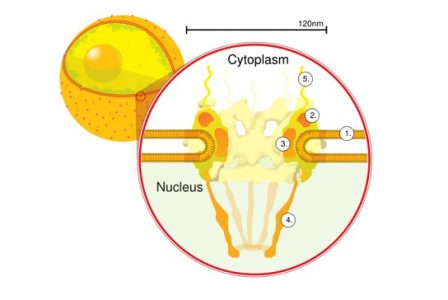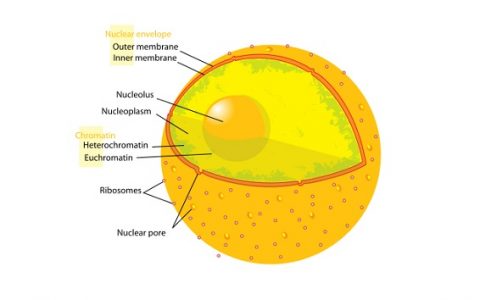Nuclear Membrane Definition
The nuclear membrane, also called the nuclear envelope, is a double membrane layer that separates the contents of the nucleus from the rest of the cell. It is found in both animal and plant cells. A cell has many jobs, such as building proteins, converting molecules into energy, and removing waste products. The nuclear envelope protects the cell’s genetic material from the chemical reactions that take place outside the nucleus. It also contains many proteins that are used in organizing DNA and regulating genes.
Function of the Nuclear Membrane
The nuclear membrane is a barrier that physically protects the cell’s DNA from the chemical reactions that are occurring elsewhere in the cell. If molecules that stay in the cytoplasm were to enter the nucleus, they could destroy part of the cell’s DNA, which would stop it from functioning properly and could even lead to cell death. The envelope also contains a network of proteins that keep the genetic material in place inside the nucleus.
It also manages what materials can enter and exit the nucleus. It does so by being selectively permeable. Only certain proteins can physically pass through the double layer. This protects genetic information from mixing with other parts of the cell, and allows different cellular activities to occur inside the nucleus and outside the nucleus in the cytoplasm, where all other cellular structures are located.
Parts of the Nuclear Membrane
The nuclear membrane surrounds the nucleus of the cell.
Outer Membrane
Like the cell membrane, the nuclear membrane is a lipid bilayer, meaning that it consists of two layers of lipid molecules. The outer layer of lipids has ribosomes, structures that make proteins, on its surface. It is connected to the endoplasmic reticulum, a cell structure that packages and transports proteins.
Inner Membrane
The inner membrane contains proteins that help organize the nucleus and tether genetic material in place. This network of fibers and proteins attached to the inner membrane is called the nuclear lamina. It structurally supports the nucleus, plays a role in repairing DNA, and regulates events in the cell cycle such as cell division and the replication of DNA. The nuclear lamina is only found in animal cells, although plant cells may have some similar proteins on the inner membrane.
Nuclear Pores
Nuclear pores pass through both the outer and inner membranes of the nuclear membrane. They are made up of large complexes of proteins and allow certain molecules to pass through the nuclear membrane. Each nuclear pore is made up of about 30 different proteins that work together to transport materials. They also connect the outer and inner membranes.
During cell division, more nuclear pores are formed in the nuclear membrane in preparation for cell division. The nuclear membrane eventually breaks down and is reformed around the nuclei of each of the two daughter cells.
The figure below shows a nuclear pore close-up:

Differences Between Nuclear Membranes in Plant and Animal Cells
Much more is known about animal and yeast cell nuclear membranes than those of plant cells, but the knowledge gap is decreasing thanks to recent research. Plant nuclear membranes lack many of the proteins that are found on the nuclear membranes of animal cells, but they have other pore membrane proteins that are unique to plants. Animal cells have centrosomes, structures that help organize DNA when the cell is preparing to divide; plants lack these structures and appear to rely entirely on the nuclear membrane for organization during cell division. With further research, scientists may better understand the uniqueness of plant cell nuclear membranes.
Related Biology Terms
- Cytoplasm – all the material in a cell excluding the nucleus.
- Nucleus – central structure in a cell that contains the cell’s genetic material.
- Lipid bilayer – a double layer of lipid molecules; the outer cell membrane and the nuclear envelope are each made up of a lipid bilayer.
- Ribosome – a structure in the cell that makes proteins. Some ribosomes are attached to the outside of the nuclear envelope.
Quiz
1. Which is NOT a part of the nuclear membrane?
A. Outer layer
B. Middle layer
C. Inner layer
D. Nuclear pores
2. What is the function of the nuclear membrane?
A. To allow different cellular activities to take place in the nucleus and in the cytoplasm at the same time
B. To regulate the transportation of molecules into and out of the nucleus
C. To protect the genetic information
D. All of the above
3. What does the nuclear lamina do?
A. It organizes and provides structural support for the nucleus, including the chromosomes within
B. It laminates the nucleus, making it easier for molecules to enter during DNA replication
C. It holds the ribosomes in place on the nuclear membrane for protein production
D. It extends out into the cytoplasm to gather chemical information

